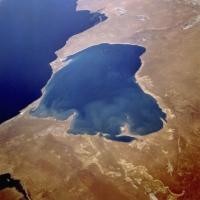In the new geostrategic "Great Game" between Russia and the West over the future of Caspian and Central Asian energy resources, the prize resembles a set of traditional matreshka Russian dolls. The outermost doll represents the three nations bordering the Caspian itself -- Azerbaijan, , Kazakhstan and Turkmenistan. In the middle of the collection is Uzbekistan, the most populous of the new Central Asian nations. The innermost doll consists of the two most easterly "Stans," Kyrgyzstan and Tajikistan, rich in hydroelectric potential, but relatively poor in hydrocarbons. As prizes go, it is certainly a tempting one. The Caspian's 143,244 square miles and attendant coastline are estimated to contain as much as 250 billion barrels of recoverable oil, boosted by more than 200 billion barrels of potential reserves. That's aside from up to 328 trillion cubic feet of recoverable natural gas. Since 1991, the focus of Washington's regional policy has been the construction, wherever possible, of multiple export pipeline routes, bypassing both Russia and charter "axis of evil" member, Iran. When the post-Soviet struggle to control Caspian and Central Asian energy began in earnest after 1991, each side had an advantage. Western energy companies had investment cash and expertise, and concentrated on convincing Azerbaijan and Kazakhstan to buy into Western development of their energy assets and the accompanying Western-oriented export routes. The Russian Federation, meanwhile, inherited the vast skein of Soviet-era oil and natural gas pipelines, most notably the Central Asia-Center natural gas pipeline system. In the subsequent tug of war with Western energy companies, the pipelines, which despite Yeltsin's fire sale of Soviet assets remained a state monopoly under Transneft, would be be a major asset.
Central Asia’s Energy Chessboard

